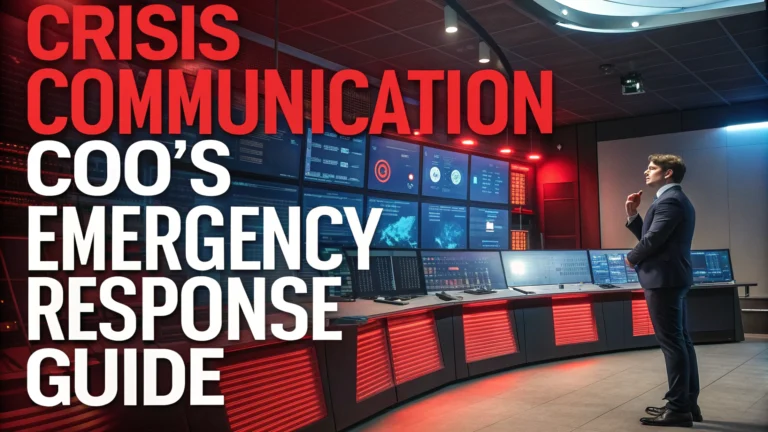A Chief Operating Officer’s ability to manage crisis communication effectively can determine an organization’s survival during emergencies.
Emergency response requires clear protocols, rapid decision-making, and coordinated communication channels to protect both the organization and its stakeholders.
This quick guide outlines practical steps for COOs to build and execute an effective crisis communication strategy.
Building Your Crisis Communication Framework
- Establish a Crisis Management Team (CMT)
- Define clear roles and responsibilities
- Create emergency contact lists
- Develop message templates
- Set up multiple communication channels
First Response Actions
Activate your crisis management team within the first 15 minutes of crisis detection.
Gather initial facts and assess the situation’s severity using the FACTS method:
- Facts: Collect verified information
- Audience: Identify affected stakeholders
- Channels: Select appropriate communication platforms
- Timing: Determine response urgency
- Scope: Evaluate crisis impact
Communication Channels Matrix
| Stakeholder | Primary Channel | Backup Channel |
|---|---|---|
| Employees | Internal messaging system | SMS/Phone tree |
| Media | Press release | Social media |
| Customers | Email/Website | Social media |
Message Development Guidelines
Follow the 3R approach for crisis messaging:
- Regret: Acknowledge the situation
- Reason: Explain what happened
- Remedy: Share action plans
Legal Considerations
Always consult with legal counsel before releasing statements during a crisis.
- Document all communications
- Avoid speculative statements
- Maintain confidentiality where required
- Consider regulatory requirements
Social Media Response Protocol
Monitor social media channels continuously during a crisis.
- Assign dedicated social media responders
- Use pre-approved response templates
- Track mention sentiment
- Document all interactions
Post-Crisis Recovery Steps
- Conduct a thorough debrief
- Document lessons learned
- Update crisis plans
- Retrain team members
- Test revised procedures
Essential Resources
Keep these emergency contacts readily available:
- Legal counsel: [Insert contact details]
- PR firm: [Insert contact details]
- Local emergency services: 911 (US)
- IT security team: [Insert contact details]
- Employee assistance program: [Insert contact details]
Moving Forward: Strengthening Your Crisis Readiness
Schedule monthly reviews of your crisis communication plan to ensure it remains current and effective.
Conduct regular crisis simulation exercises with your team to maintain readiness.
Build relationships with key stakeholders before crises occur to ensure smoother communication during emergencies.
Training and Development
Implement regular crisis communication training programs across all organizational levels.
- Quarterly simulation exercises
- Role-playing scenarios
- Media training for spokespersons
- Cross-functional team drills
Technology Integration
Leverage technology solutions to enhance crisis communication effectiveness:
- Emergency notification systems
- Crisis management software
- Digital command centers
- Analytics and monitoring tools
Key Software Requirements
| Function | Tool Type | Purpose |
|---|---|---|
| Notification | Mass alert system | Rapid stakeholder communication |
| Monitoring | Social listening platform | Real-time sentiment tracking |
| Documentation | Crisis management platform | Incident tracking and reporting |
Measuring Communication Effectiveness
- Response time metrics
- Message penetration rates
- Stakeholder feedback analysis
- Media coverage assessment
- Social media engagement tracking
Building Long-term Crisis Resilience
Transform crisis experiences into organizational strength through systematic learning and adaptation.
- Develop comprehensive incident databases
- Create best practice repositories
- Establish continuous improvement protocols
- Foster a culture of preparedness
- Maintain strong stakeholder relationships
Fortifying Your Organization’s Future
Effective crisis communication management requires continuous evolution and adaptation. By implementing robust frameworks, leveraging technology, and maintaining strong stakeholder relationships, organizations can navigate crises while preserving reputation and trust.
Remember that crisis preparation is an ongoing journey, not a destination. Regular updates, training, and relationship building are key to maintaining crisis readiness and organizational resilience.
FAQs
- What are the first actions a COO should take when a crisis occurs?
Immediately activate the crisis management team, assess the situation’s severity, gather essential facts, and establish a secure communication channel for leadership. Ensure employee safety first and initiate the predetermined crisis response protocol. - How should a COO structure the crisis communication chain of command?
Establish a clear hierarchy with designated spokespersons, backup communicators, and specific roles for each team member. Include legal counsel, PR teams, and department heads with direct reporting lines to the COO. - What essential information should be included in the initial crisis communication message?
Include what happened, immediate actions being taken, impact on stakeholders, safety measures in place, and next steps. Provide verified facts only, acknowledge what is unknown, and include contact information for further updates. - When should a COO involve external crisis communication specialists?
Engage external specialists when the crisis exceeds internal capabilities, involves significant reputational risk, requires specialized expertise, or impacts multiple jurisdictions or stakeholders. - How frequently should crisis updates be communicated to stakeholders?
Provide regular updates at predetermined intervals, typically every 2-4 hours in the acute phase. Adjust frequency based on crisis severity, stakeholder needs, and development of new information. - What are the key components of a crisis communication toolkit?
Include emergency contact lists, pre-approved message templates, stakeholder mapping, media protocols, social media response guidelines, and holding statements for various scenarios. - How should a COO handle media inquiries during a crisis?
Designate a single point of contact for media, prepare key messaging points, stick to verified facts, maintain consistent messaging across all channels, and ensure all responses align with legal and PR guidance. - What documentation should be maintained during crisis communication?
Keep detailed logs of all communications, decisions made, actions taken, media inquiries, stakeholder responses, and timeline of events. This documentation is crucial for post-crisis analysis and potential legal proceedings. - How should social media be managed during a crisis?
Monitor all platforms continuously, respond promptly to misinformation, maintain consistent messaging across platforms, and designate specific team members for social media response and monitoring. - What are the critical elements of post-crisis communication?
Include assessment of response effectiveness, stakeholder feedback collection, documentation of lessons learned, updates to crisis communication plans, and clear communication about resolution and preventive measures.
